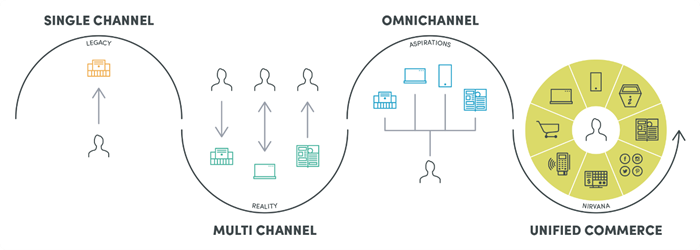Unified Commerce Eliminates Customer Experience Silos
Recently Insite Software released a white paper called "Unifying the B2B Commerce Experience", discussing the real components of Unified B2B eCommerce and what the true  measures are that make a successful B2B buying experience. I was interested to look deeper into what unified commerce because today, if you want to succeed at ecommerce it takes more than just a pretty website, organizations need to create sites that engage customers while maximizing their buying but still saves time.
measures are that make a successful B2B buying experience. I was interested to look deeper into what unified commerce because today, if you want to succeed at ecommerce it takes more than just a pretty website, organizations need to create sites that engage customers while maximizing their buying but still saves time.
Gartner reported that 89% of businesses soon expect to compete mainly on customer experience which is fast becoming the key brand differentiator, above both price and product. People are willing to pay more for a product if they receive a great customer experience and since retailers are adding more selling channels, the customer experience is becoming more and more difficult to manage for every touchpoint.
With that in mind retailers are realizing the need for a for a seamless customer experience across all channels but knowingly admit they aren't currently doing it well. They don’t have the technical capabilities necessary to make it happen and with the fear of customer churn due to bad experiences looming, retailers are looking to unified commerce but the good news is, according to a survey carried out by Boston Retail Partners (BRP), 81% of retailers will have deployed unified commerce by the end of 2020.
So what exactly is unified commerce: Defined by BPR, unified commerce places the customer experience as first priority by leveraging a single commerce platform. A single platform rids of internal channels that operate in their own silos. Instead, merchants leverage a “single, centralized, real-time platform for all customer engagement points.” In this way, unified commerce is achieved.
You may think that unified commerce sounds a lot like omnichannel and you aren’t alone, many marketers thought the same. But that isn’t so because in omnichannel, there are multiple channels but the main difference is they do not converge on one unique software or platform. Generally, every channel has separate, stand-alone operating systems that make a bigger disparate system with various silos. Inconsistent data is shared across and there is no single unified data crossing the channels.
In unified commerce the web, the mobile apps or site, the physical store are all connected and operate in symbiosis in real time. Consistent data is shared across platforms, avoiding inaccurate information.

Advantages of Unified Commerce
There are many advantages of unified commerce for both the retailer and customer but the main advantage is shown in the enhanced customer experience.
Customers want to be able to buy anywhere, receive anywhere, and return anywhere. If they buy online, they want to return in-store. The level of expectation goes even beyond. For example if an item is out-of-stock in-store, the salesperson should be able to place an order online for them, allow them to pay in-store and then have the item shipped either to the store or the customer's home.
Customers also demand accurate, consistent product information when shopping online. They should see inventory availability across stores, product descriptions should be detailed and consistent across channels and translate from the shopping pages of a site through to cart to purchase. Product recommendations should also be relevant and timely based on past purchase history.
This type of experience isn’t easy to achieve. Business should share real-time data across the organization and systems and unified commerce makes it happen. Here are some of the main advantages a unified platform offers, that builds better customer experiences:
Online Purchasing
Customers need to have accurate product information easily, when making purchases online. Providing information to customers is critical and with a unified platform it's easy to supply: inventory availability across stores, detailed product descriptions across channels, relevant product recommendations and past purchase history.
Inventory Visibility
Selling across multiple channels and keeping inventory quantities updated in real-time is critical, as overselling and frustrating customers is a problem to avoid at all costs. Unified commerce allows retailers to perform endless aisle meaning customers can buy products that are out-of-stock in physical stores because inventory visibility supports inventory management and can ensure that your customers have the products to buy.
Delivery Options
Customers want a seamless shopping experience, whether it's online or offline. A unified platform offers this seamless experience and allows merchants to improve services by offering options such as buying online, picking up in-store, returning in-store etc.
Simplified Platform
Calling for a single platform, unified commerce can be brought down to a simplification of multiple channels. The technology needed itself is simplified as brands and retailers no longer need separate systems to run separate channels.
Ending Notes
With all customer engagement points connected in real time, unified commerce will let you deliver a holistic and personalized customer experience more consistently. Meaning you can treat each customer as the individual they are all the time – one person with one account.
Forrester’s Mary Shea put it this way in B2B Buyers Make The Case For Better Marketing And Sales Alignment, “Your buyers want contextual interactions with both human and digital assets across a holistic but non-linear journey. And, by in large, they want their experiences with sales people to be high value or frictionless."
I think in no time, retailers of all sizes will be putting unified commerce to good use.

Natalie Evans
Natalie Evans has over 16-years in the tech industry and currently works as the event coordinator and tech reporter for CMS-Connected, keeping up-to-date on what's happening in and around the Content Management industry.